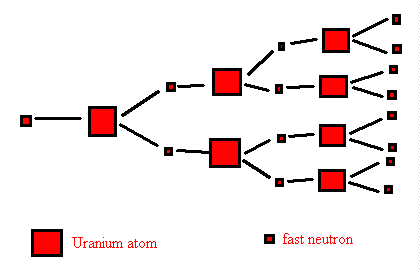
What is Nuclear Power?
Here's a brief summary:
The fuel used is uranium. One form of it (U-235) emits a small number of particles called neutrons. They travel at a
very high speed - thousands of metres per second.
If you have a block of U-235, there's a good chance that a neutron given off in
one part of it will hit a neighbouring uranium atom. If it hits the centre
of the atom (the nucleus) it may cause it to release two
neutrons, travelling equally quickly, and two fission fragments - atoms with
about half the mass of a uranium atom, also travelling very quickly.
This is shown in the diagram.

Each of these neutrons may also collide with other uranium
atoms, a collision releasing two more neutrons and fragments. You can see that, very rapidly, we
end up with an enormous number of fast moving particles.
If you cast your mind back to your secondary school Physics lessons...... fast particles mean
kinetic energy, which ultimately means HEAT ... if there is enough uranium
surrounding the original neutron (the "critical mass"), the
doubling continues uncontrolled, the energy goes up almost to infinity in a few
milliseconds and we have a nuclear bomb - an enormous explosion. (In an atomic bomb, two
sub-critical masses are brought together).
A nuclear power station is quite different. The uranium isn't in just one
or two pieces; it's split into thousands of fragments, arranged into
hundreds of "fuel elements", each one surrounded by neutron absorbing
material.
The number of neutrons produced by "doubling" is severely limited.
If the number of fast neutrons
is controlled in this way, it still produces a great deal of heat.
This is used (in a number of steps)
to pass hot gas to a turbine,
which works a generator, and electricity is produced.
It's called nuclear energy because it
comes from the nucleus of the atom.
At one time, the UK were world leaders in nuclear energy technology.
About 15% of the world's energy is produced in this way. France is
about 80% nuclear; the UK about 20%.
Nuclear energy creates no greenhouse gases. There is
enough uranium-235 to supply all the energy we need for hundreds
of years.
There is also more than enough hot air.
NOTE: BACKGROUND ON URANIUM
Commodity.com has published a concise guide to uranium, covering how uranium is produced, how it is used, and how its use has altered over time. This includes some interesting historical background and lots of pictures.
See https://commodity.com/energy/uranium/ .